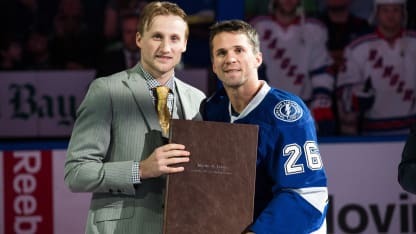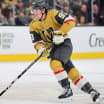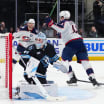TAMPA --He woke up invincible.
That morning, Steven Stamkos was 23 years old and flying. He was playing his most confident hockey, his most fun hockey, his best hockey, with 23 points (14 goals, nine assists) in 16 games. Perhaps there would be more that day in Boston.
Reborn Stamkos powering Lightning to top of NHL standings
Center has become playmaker after four major surgeries

That was the point, really. There were always more games ahead for the Tampa Bay Lightning center. More goals ahead.
That's what it was like to be Stamkos on Nov. 11, 2013, utterly sure of himself, utterly fearless, in exactly the place he wanted to be, doing exactly what he wanted to be doing, toying with the hockey world, at the height of his game and on his way to the 2014 Sochi Olympics.
And then there he was, flat on his stomach at TD Garden, pounding the ice with his fist. Stamkos' right tibia was broken, the result of a backcheck and a collision with then-Boston Bruins defenseman Dougie Hamilton and the right post of the Lightning goal.
He was taken off the ice on a stretcher, no longer invincible, no longer the player who had never missed a game because of injury. He would play 37 games that season, returning in March, missing the Olympics. He would come back to play 82 games the following season and 26 in the Stanley Cup Playoffs, the Lightning losing against the Chicago Blackhawks in six games in the Eastern Conference Final.

© Brian Babineau/Getty Images
But the next two seasons would be cut short. Surgery to repair a blood clot on April 4, 2016, cost him all but one game of that season's playoffs. It was even worse in 2016-17, when a torn lateral meniscus in his right knee ended his season one month after it had begun.
So who was he then, before the broken leg and the blood clot and the torn meniscus?
"I was a young kid who was on top of the world," Stamkos said.
Who is he now?
He laughed, amused, rueful.
"I'm four major surgeries later," Stamkos said, counting a follow-up procedure for the blood clot. "It's tough. I'm a different person, for sure."
And yet, Stamkos, 27, is back on top of the world, with Tampa Bay having the best record in the League. He has 58 points (18 goals, 40 assists) in 49 games, tied for third in the scoring race. He got married last summer and has been named captain of the Atlantic Division in the 2018 Honda NHL All-Star Game, to be played at Amalie Arena, home of the Lightning, on Sunday (3:30 p.m. ET; NBC, CBC, SN, TVA Sports).
It is even possible he is better now than he was on that day in November 2013, smarter, with a reinvented role and a greater understanding of hockey, of himself.
He might not be the scorer he once was, but he has made up for it as a playmaker, working with the younger, faster Nikita Kucherov as his linemate. He might not be able to move the way he once did, but he has worked with trainers to prepare his body better, to adapt, as he puts it, to "the new normal." He might not be the same carefree kid, but he is wiser and more determined, knowing what that loss is like.
Stamkos is changed, and wary. He knows how easy it is for everything to vanish.
He also knows he can rise again.
\\\\
Through the first 389 games of his NHL career, up to but not including the one Nov. 11, 2013, Stamkos had 222 goals, a pace that put him amongst the all-time great goal scorers. If Stamkos had played, say, 80 games per season over a 15-year career, that goals per game average (0.57) would have given him 685, one more than Teemu Selanne, who ranks 11th in NHL history.
Instead, through the next 244 games of his career, stops and starts, comebacks and more injuries, Stamkos scored 116 goals, for a pace of 0.475, a number that has dropped even further this season, to 0.367.
He was playing his best hockey when he broke his leg. And again, when he tore up his knee.
He felt the injustice. The disappointment. The wonder at what could have been. These were prime seasons Stamkos missed, prime years, his mid-20s. These were years that likely should have seen him at his absolute best. Instead, he was in press boxes and gyms, waiting and watching.

© Scott Audette/Getty Images
"Absolutely you think about it a little bit," said Stamkos, who has 640 points (339 goals, 301 assists) in his 635-game NHL career. "Could have scored 40 this year, could have scored 50 this year. Couldas and shouldas and wouldas. Unfortunately, that stuff happened. Nothing I can do about it now."
His absences became a source of gallows humor among the Lightning, those who know how tied their fortunes are to the health of the Tampa Bay captain. As defenseman Anton Stralman said, "We usually joke in the dressing room that he never misses a game. If he goes down, he goes down for a while."
He is there, and then he is simply gone, forced away from the team and slogging through the process of healing, of returning, of winding his way back to normal.
"Injuries happen," Lightning coach Jon Cooper said. "It's just the magnitude of his injuries is what's a little bit mind-boggling. You miss five games here or six games here, but you miss 45 and 60-plus and you miss a whole playoff run and that's the tough part because, and any player will tell you, it's not the physical part that hurts, it's the mental part."

© Jamie Sabau/Getty Images
Stamkos found that to be true. The days of rehab and recovery crept by, so slowly, the monotony and isolation of the gym tearing at him. It is a lonely pursuit, coming back from an injury, especially a major one, especially one after another after another. The mind dips in those moments, questions.
"Listen, there's a lot of days where the pity party was there," Stamkos said. "You're going to have those days. I think that's where it helped me knowing that it's OK to have those days sometimes. There's nothing wrong with asking why."
He tried to keep those days to a minimum, quieting the doubts and the despondency, channeling them into what he needed to do, which was get better. He had to push himself, to understand what the Lightning might need from him, and to become that person, that player. He did it hour after hour, day after day, month after month, pushing and pushing and pushing, even when the self-pity nearly swallowed him whole. Even when he had to take a first tentative, scared step after not walking for so long.
Even when there was a screw protruding from his leg.
\\\\
About that screw.
It was the summer after his broken leg, 2014, and Stamkos was training with former Lightning teammate Gary Roberts, who had seen Stamkos was having some problems with his leg and tried to get him to take it easy.
Stamkos was not easily persuaded.
By the end of the workout, Roberts noticed something. The screw, which had been inserted at the top of Stamkos' knee when a 16-inch titanium rod was put in his tibia, with another screw at his ankle, was bulging, protruding from his skin.
Roberts was stunned. Here was his pupil, tearing up the weight room and the track, pushing through and past anything he had ever done, all while Roberts could see the screw.
"I remember we were doing a track workout," Stamkos said. "I felt unbelievable. The screw in the top of the knee, sometimes over time it just loosens up in there and starts to protrude out a little bit. It was bugging me a little bit, but I remember we were on the track and I was flying. It was probably the fastest I was running that summer."
Stamkos had come back in March that season, too late to go to the Olympics, but with enough time to finish the season, to play in the four-game loss to the Montreal Canadiens in the Eastern Conference First Round. He was gearing up for the following season, when he would play 82 games and the Lightning would reach Game 6 of the Stanley Cup Final against the Chicago Blackhawks, a season when it seemed everything was back in its rightful place, that he was back to his rightful place.

© Scott Audette/Getty Images
Stamkos felt so good that summer of 2014, so strong, that he didn't want to lose momentum. He didn't want to lose more than he already had the season before. He was starting to understand the ways he needed to work to ready his body, to ready his mind.
He was laying the foundation for all he would do -- all he would have to do -- in the years to come.
The screw would be removed in August. But that feeling wouldn't go away. He wanted to push himself and push himself. He burned to be his old self again, the Stamkos who could do anything.
"That's who he is," Roberts said. "Came in limping, and the next thing you know, no one could catch him out there."
\\\\
Some days, it still seems no one can catch him. It seems easy, with the way Stamkos and Kucherov move together, fly together, create magic together, though of late their line has been separated by Cooper. As Kucherov, 24, said, "You get better just looking at him and see what he does and how he does it."
Stamkos coming back was something none of the Lightning ever really doubted. They believed he deserved it, having watched him through all the trials, all the disappointments. They knew he wanted it.
They didn't necessarily know this type of performance was possible.
"I don't think anybody expected him to play as well [as he is]," Stralman said. "I didn't. No offense to him."
Especially the way he started this season, with two assists and two more and one more after that, with at least one point in his first 11 games, with 20 points (three goals, 17 assists) in his first 10 games, 35 points (10 goals, 25 assists) in his first 19.
These were crazy numbers for anyone, especially for someone who hadn't played for about a year.
They also weren't Stamkos numbers.
This, after all, is a player known as a goal scorer, known for his one-timer. He has scored at least 43 goals four times, scoring 51 in 2009-10 and 60 in 2011-12.
But that's not what he has done this season, with statistics that easily could make someone look twice at the name attached to the numbers. Though that pace hasn't quite been sustained, Stamkos is on pace to finish with more assists than goals for the second full season in his NHL career; in 2010-11, he had 45 goals and 46 assists.
He is not the same Steven Stamkos.
Part of that can be attributed to Kucherov, who has proven to be a player worthy of having plays made for him, who has a shot and a finish to rival Stamkos. Part of that can be attributed to the changes that have been the inevitable conclusion of the injuries and the rehab Stamkos has gone through.
Part of that can be attributed to his understanding of who he is and who he can be on the ice, and how that impacts the Lightning.
He can build and create. He can distribute. It can work.
"I think we just understand the game the same way," Kucherov said. "If the guy [is] ahead of you, just give it to him and get open, find an open area. For us, we just want to play fast, want to shoot the puck a lot, and create some confusion in the 'D' zone for opponents."
That is what Stamkos keeps saying, that he hasn't remade his game, that it has just been Kucherov open for the opportunities, open for those passes. But it says something, too, that Stamkos is willing to feed his linemate, that he is willing to transform his game, even if perhaps it's also because he has needed to transform.
"When I first got here [in 2014] he was more of a shooter, now he makes some really, really nice plays too, matching his scoring abilities with his playmaking skills," Stralman said of Stamkos. "So I think he really, really is a complete player."
\\\\
He is more complete in other ways, too. Stamkos' friends are getting married, having children, settling down. He is no longer in his early 20s and, looking around the Lightning dressing room at Amalie Arena, he notes most of his teammates are younger than he is, earlier in their careers, with more hockey ahead of them than he has.
"Now you get to this age and it's like, we're going to this wedding and that wedding and this friend's having a baby. You're getting to that stage, whether you like it or not," Stamkos said. "We could all wish we stayed 22, 23 years old, but it's fun, too. It's fun to be one of the older guys in the room, the guy who's been in the organization the longest. I take pride in that."
He is the captain. The leader. The face of the Lightning, though perhaps no longer the face of the League. That has become the domain of younger players, of a generation of Connor McDavid and Auston Matthews and youth and speed that Stamkos cannot always relate to anymore.
He is young in the scheme of things, but not so young in hockey. It is his 10th season in the NHL, more than a third of his life spent fighting for every game, every point, every win. He has realized what once came so very easy no longer does.

© Mark Blinch/Getty Images
"It's tough to sit back and think that at the end of all this that it's going to make you better," Stamkos said. "It does. You have a bigger appreciation of what you do and the sacrifice you have to make, all the tough rehab days, all the ups and downs of thinking if you can get back to that elite level and hoping that you do and hoping that all the work you put in works -- and just wanting to win so much more now because of everything you've gone through, having been close a few times and realizing that at 28 in February that you're not necessarily the young guy anymore, especially the way this League has gone."
It happens fast.
"It happens really fast," he said.
"I don't think I'll ever know what it felt to be that 23-year-old who had never had an injury before, never had to worry about that, and just came to the rink and played and enjoyed hockey," Stamkos said. "You get out of bed every day now and it takes a while to get going and warm the body up. It's the new norm for me, and it's just about finding ways around that."
There are aches and pains. There are ramifications of each injury, each surgery. They have left their mark on him, physically, mentally, emotionally, leaving him scarred in multiple ways, yet secure in the knowledge of what it takes to bring himself back.
"I think each one has helped me prepare for the next one, if that makes sense in a sad kind of way, that I understand what the body has to go through and then what the mind has to go through, and how powerful that mind is, and how to push that stuff to the side," Stamkos said. "It's become easier from a mental standpoint to get over that stuff."
There are still barriers for him, getting used to what he can and cannot do on the ice, the limitations imposed by injury and time. There are still mental hurdles, making sure he reacts the right way and doesn't try to protect himself on the ice, making sure he can play as freely as he once did, without the worries and the hesitation.
But there also is a newly reborn player, one with the freedom to know if he falls, if he gets hurt, if he misses time, he knows how to come back. He knows how to make himself stronger. He knows how to reinvent himself. He knows he can become a different player, and send his team soaring again.
He can score and distribute. He can lead and be led.
He can be the best. He can make the Lightning the best, the position they have occupied for most of the season, one that could end with the Stanley Cup ring Stamkos has been seeking for a decade.
He may no longer be invincible. He may no longer be 23. But there is more to be seen from Steven Stamkos. He is back on top of the world, and he can still fly.

















